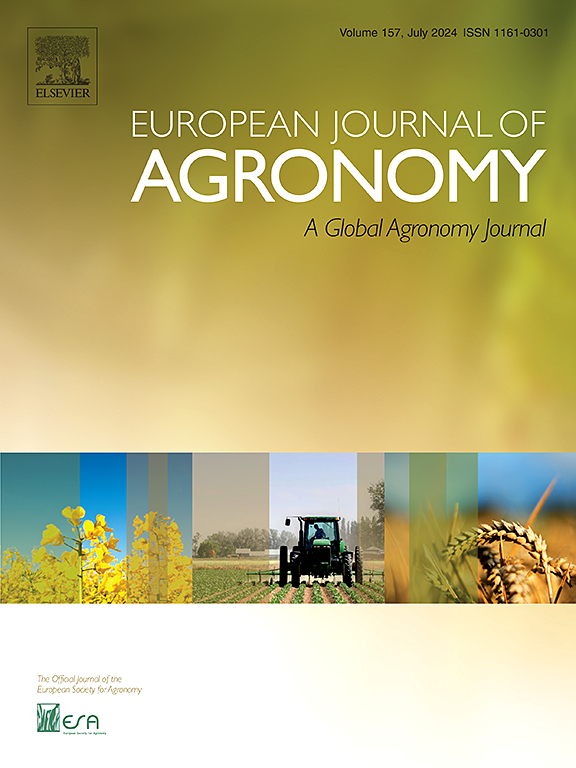收获时间对水稻产量和品质的影响:一项荟萃分析
IF 4.5
1区 农林科学
Q1 AGRONOMY
引用次数: 0
摘要
收获时机对水稻产量和品质有显著影响,最佳收获时机因品种和地区而异。为了阐明不同收获期对水稻产量和品质的影响,强调水稻品种和地区对收获期和适宜籽粒含水量的影响。以抽穗后35 d和22-24 %含水率为对照,对CNKI和Web of Science(截至2024年)的32项研究(977对数据)进行meta分析。结果表明,早熟(与抽穗后35天采收相比)减产5.76 %,延迟采收增产8.31 %,粒重增产9.32 %,但热带地区产量变化不显著。延迟收获也提高了抽穗后25 ~ 55天的抽穗率,但在热带地区使抽穗率降低了20.51% %,早收和晚收均使白垩度提高了15.37% %。此外,延迟收获使直链淀粉含量提高了3.36 %,味道值提高了42.93 %,同时降低了蛋白质含量和粘度。特别需要注意的是,在22-24 %的最佳含水率范围之外收割会显著降低产量和抽穗率。总的来说,虽然延迟收获可以改善一些品质性状,但可能会降低外观质量,其影响因地区和品种而异。相反,最佳水分范围的效益是一致的,在22 % -24 %的水分范围内,产量和抽穗率最高。这些研究结果为确定最佳收获时机以获得高产优质水稻提供了理论依据。本文章由计算机程序翻译,如有差异,请以英文原文为准。
Effects of harvest time on rice yield and quality: A meta-analysis
Harvest timing significantly affects rice yield and quality, with optimal timing varying by variety and region. In order to elucidate the effects of different harvest timings on rice yield and quality, and emphasize the impact of rice varieties and regions on harvest timing and suitable grain moisture content. Using 35 days after heading and 22–24 % moisture content as controls, 32 studies (977 data pairs) from CNKI and Web of Science (up to 2024) were meta-analyzed. The results showed that premature harvesting (compared to harvesting 35 days after heading) reduced yield by 5.76 %, while delayed harvesting increased yield by 8.31 % and grain weight by 9.32 %—though no significant yield change in torrid zones. Delayed harvesting also improved head rice rates from 25 to 55 days after heading, but decreased them by 20.51 % in torrid zones, and both early and late harvests increased chalkiness by 15.37 %. Additionally, delayed harvesting raised amylose content by 3.36 % and taste value by 42.93 % while reducing protein content and viscosity measures. It is particularly necessary to note that harvesting outside the optimal 22–24 % moisture range significantly lowers yields and head rice rates. Overall, while delayed harvesting can improve some quality traits, it may reduce appearance quality, with effects varying by zone and variety. In contrast, the benefits of the optimal moisture range are consistent, with the highest yield and head rice rate achieved at 22 %–24 % moisture. These findings provide a theoretical basis for determining optimal harvest timing to achieve high-yield, high-quality rice.
求助全文
通过发布文献求助,成功后即可免费获取论文全文。
去求助
来源期刊

European Journal of Agronomy
农林科学-农艺学
CiteScore
8.30
自引率
7.70%
发文量
187
审稿时长
4.5 months
期刊介绍:
The European Journal of Agronomy, the official journal of the European Society for Agronomy, publishes original research papers reporting experimental and theoretical contributions to field-based agronomy and crop science. The journal will consider research at the field level for agricultural, horticultural and tree crops, that uses comprehensive and explanatory approaches. The EJA covers the following topics:
crop physiology
crop production and management including irrigation, fertilization and soil management
agroclimatology and modelling
plant-soil relationships
crop quality and post-harvest physiology
farming and cropping systems
agroecosystems and the environment
crop-weed interactions and management
organic farming
horticultural crops
papers from the European Society for Agronomy bi-annual meetings
In determining the suitability of submitted articles for publication, particular scrutiny is placed on the degree of novelty and significance of the research and the extent to which it adds to existing knowledge in agronomy.
 求助内容:
求助内容: 应助结果提醒方式:
应助结果提醒方式:


